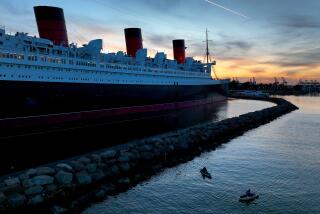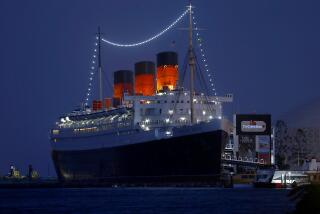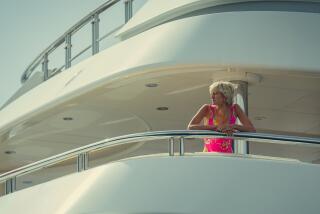Polishing Up a Queen’s Faded Beauty : History: In restoring Queen Mary to its original luster, Walt Disney Co. goes to great lengths to retain the former luxury liner’s authenticity.
- Share via
LONG BEACH — You can’t expect nostalgia to work perfectly.
The Walt Disney Co. is sinking more than $2 million into restoring the Queen Mary to its former glory, but that doesn’t mean the saltwater faucets are going to work. And a flick of the call buttons will no longer summon a steward or stewardess to your bath with fresh towels.
But the faucets and buttons are still there. That’s because the 56-year-old luxury liner is regarded as historically significant. So everything is being preserved that it is possible to save. And what can’t be saved is being replaced with similar materials.
That meant that when it came to giving the aging Queen a face lift, Irvine-based J. Ray Construction and the Walt Disney Co., which operates the hotel, had their work cut out for them.
“It’s like getting things off the Titanic,” said Jane Muszynski, an interior designer who is coordinating the project. “They’re antiques.”
Disney and J. Ray, in fact, have to account to the city of Long Beach--which owns the Queen Mary--for every knob and chaise longue that they cart offshore.
Since fall, Disney and J. Ray, as general contractor, have been busy remodeling the ship’s 365 hotel rooms. When done--possibly in late March--the rooms will have new carpeting, furnishings and drapes. The front desk area and the lobby--originally the ship’s first-class purser’s office--will have been refurbished as well.
With a hotel occupancy rate that now hovers at an impressive 75-80% year-round, and with single-room rates that start at $95 and soar to $650 a night for one of the nine suites named after former occupants like Winston Churchill and King George, the Queen Mary is doing very well indeed.
Still, one goal of the current renovation is to boost occupancy rates even higher, said Rich Kerlin, spokesman for Disney’s Long Beach attractions.
Another goal is to help boost the Queen’s stature with hotel rating groups--it now gets only a lackluster two stars from the Mobil Travel Guide.
Kerlin says the unimpressive rating is because the ship does not have a functional swimming pool. Adding one is being considered, he said.
The long-overdue changes were ordered after Disney bought the assets of the Wrather Corp. in early 1988. The deal included Wrather’s lease and operational agreement for the Queen Mary and the Spruce Goose--the huge wooden airplane built, mostly of birch, by Howard Hughes.
Since then, Disney has begun sprucing up the attractions, including upgrading the retail outlets on the Queen Mary and on the dock area alongside. Disney has also begun bringing in higher-quality shops. A Harrod’s outlet opened in January, and Pringle of Scotland is expected to begin selling its woolen clothing in April. Disney also is negotiating with other upscale retailers--all with a United Kingdom background--including Burberrys and Alfred Dunhill.
Remodeling an institution isn’t a first for J. Ray Construction.
The general contracting firm, founded in 1946, is probably best-known for recent projects like the $10-million Malibu Colony Plaza shopping center near Malibu and the first public school in Rancho Santa Margarita.
But J. Ray also has done renovation work on older properties, including the $7-million conversion of 32 lima bean and barley silos in Irvine into the 148-room La Quinta Inn several years ago and the 1986 rehabilitation of the Builders Exchange, a historic office building in Santa Ana.
The company, owned by brothers Michael and Walke Ray, did $33 million in construction work last year, up from $25 million in 1988, according to executive vice president Gene Sampson.
J. Ray also worked on Londontowne Village, the specialty shop area adjacent to the Queen Mary that was built to resemble a 19th-Century English village.
That previous work, combined with its bid and reputation for detail, led Disney to select J. Ray for the Queen Mary project, Kerlin said.
But even with all of the contractor’s experience, remodeling the Queen hasn’t exactly been smooth sailing.
When construction began on the Queen Mary in 1930, plans called for equipping the transatlantic liner with what then were the very latest, state-of-the-art amenities: things like fluorescent lighting tubes and plastic fittings and trim.
The result today is sometimes bizarre: the fanciest suites have hand-carved cabinets that feature off-white plastic knobs; bathrooms sport beveled mirrors that reflect the original drab gray plastic laminate in the showers.
“You see it and your first reaction is, ‘Oh! Why don’t we do something about that!” Muszynski said.
But to preserve the ship’s authenticity, the plastic remains--along with the original built-in plastic soap dishes.
“If something still has functionality, it needs to remain,” Sampson explained. The dilemma, Kerlin said, is “trying to keep the ship authentic while offering what hotel guests expect.”
So the original stateroom fans, which would no longer pass anyone’s safety standards or building codes, are being labeled “original ship fan. Not operable.” Discreetly hidden air conditioning circulates the air.
The remodeling crew also has been special-ordering brass screws by the tens of thousands for the hundreds of fluorescent fixtures that line the ship’s corridors. Although cheaper screws are available, the original fittings were brass.
And when 25 W.C.s--or water closets--had to be replaced, Disney and the contractors found themselves contacting the Scottish firm that supplied the ship’s original builder, Sampson said.
Because Disney is determined to protect the ship’s historic value as the only remaining transatlantic liner of its era, “We have to replace things in kind,” Sampson explained.
After all, it’s not as if nobody would notice.
When Disney recently painted the Queen Mary’s funnels red instead of the original orange, it wasn’t long before a maritime historical society came around, complaining about the aesthetic license being taken, Kerlin recalled.
More to Read
Sign up for The Wild
We’ll help you find the best places to hike, bike and run, as well as the perfect silent spots for meditation and yoga.
You may occasionally receive promotional content from the Los Angeles Times.






